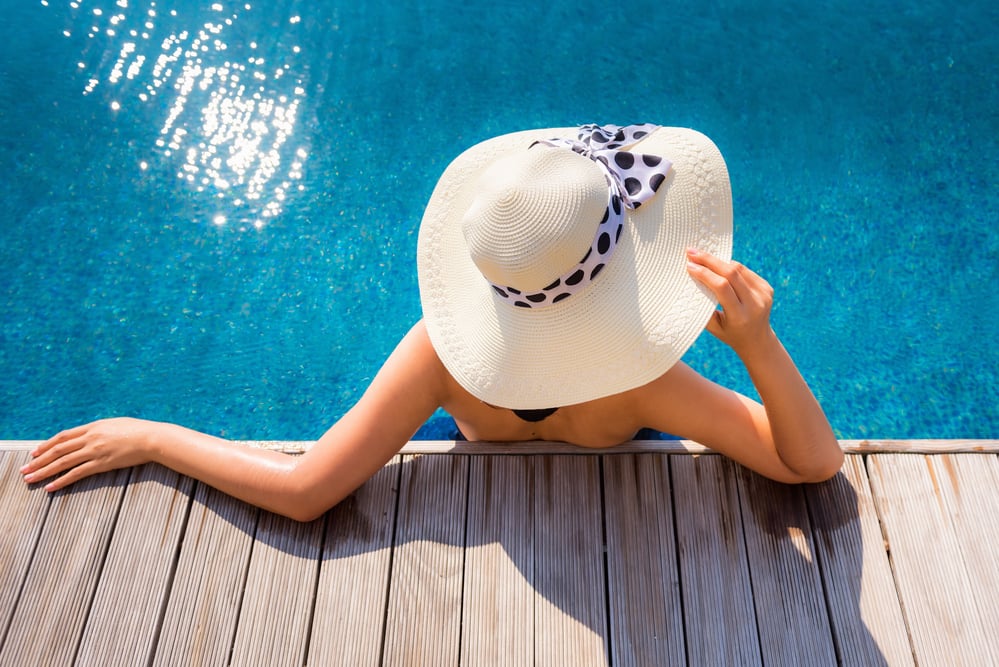
Summertime is when living is supposed to be easy, if hot. Unfortunately, summer can be a challenging time for migraine sufferers.
Because this is the season of long days of bright sunlight, extreme heat, and high humidity, it presents a fair share of triggers for migraine attacks. In fact, over 53% of people who suffer migraines reported weather changes as a trigger for their attacks.
Why Weather Changes Trigger Migraines
Barometric Pressure Changes
Changes in weather are due to changes in the barometric pressure, which is the pressure of the atmosphere around us. As the pressure fluctuates, it can trigger migraines in susceptible people.
A small study of 34 patients shows that even small decreases in pressure triggered a headache. When a storm or weather event approaches, the barometric pressure drops. The change can cause migraines. (Change is a better word than decreased pressure because there are those who experience migraines when the pressure increases as well.)
High Heat and Humidity
Exposure to heat can increase dehydration. Low humidity means you lose water more rapidly because it quickly evaporates from your skin in the form of sweat.
A study by Beth Israel Deaconess Medical Center of the effect of environmental factors in over 7,000 people with migraine provided several findings:
- Higher air temperatures in the 24 hours prior to hospitalization were most closely associated with headache symptoms. There was a 7.5% higher risk of severe headache reported for team increase of five degrees Centigrade (approximately nine degrees Fahrenheit).
- Water and sodium loss from sweating can trigger a migraine attack. The loss of sodium can dilute the bloodstream. At a certain point, the change triggers a headache.
- Extended and strenuous exercise can trigger migraines, too.
Increased Sunlight Intensity
The increase in daylight hours and the intensity of the sun in summer tend to lower melatonin levels, which in itself can be a migraine trigger. However, less melatonin can result in lower quality sleep as well. Poor sleep is another migraine trigger for many.
A study of 169 women who lived in the arctic region and suffered migraines found that 63% reported attacks were triggered by seasonal changes. Also, nearly half of those who experienced migraines with aura reported increased migraine frequency in the summer compared to 17% of those who suffered migraine without aura.
Increased sunlight also offers the chance for more exposure to light. People with migraines report photosensitivity as a migraine trigger or they say light makes the migraines more severe.
Photosensitivity may result from dysfunction in the part of the brain responsible for releasing melatonin, circling back to reduced melatonin as a migraine trigger. Exposure to light tends to suppress melatonin release more in migraineurs than the general population.
How to Cope with Summer Migraine Season
Generally, maintaining consistent eating and sleeping habits is always good migraine hygiene. In the summer, add to your self-care the avoidance of seasonal triggers and drink more water than usual.
If you suffer summer allergies, continue to take your allergy medications as part of an overall effort at preventing migraines.
Following are ten more tips for handling summer migraines.
- Watch the weather forecast. If you know a storm is coming, reconsider your planned activities. You can even obtain a digital barometer or download a weather app that can be set to notify you of approaching weather changes.
- Protect your eyes. In summer, every surface reflects bright sunlight. The blue sky, the water, even sunlight filtering through leaves can trigger or exacerbate migraines. Flickering light tends to trigger migraines, and the brighter the light, the more likely you will suffer an attack. Good quality sunglasses can help, but contoured FL-41 tinted migraine glasses do the best job mitigating the effects of bright and flickering light.
- Stay hydrated. Obviously, summer is hot. You sweat more in the heat and high humidity. Dehydration ensues, a natural trigger for headaches in almost anyone but worse for those with migraines. Eat more fresh fruits and vegetables, especially those with high water content. Increase your beverage intake as well, especially if you tend to consume caffeinated or alcoholic drinks. Both can increase dehydration.
- Avoid exertion. Physical activities in the sun and heat can lead to physical stress and, yes, dehydration. Shift your exercise routine to the early morning or late evening. If you can’t do that, shift to indoor exercise. Swimming is excellent anytime if you can protect your eyes from glare.
- Exercise indoors. As we just noted, exercise in the summer is best done in the morning or evening when the sun is lower in the sky. However, moving exercise indoors lets you control the temperature and light levels. Consider starting indoor yoga, spin class, indoor swimming, or using a gym instead of the outdoors for your exertions. If you prefer walking outdoors, do so very early or very late in the day.
- Plan your escape from heat and light. There’s no reason to give up the outdoors altogether in the summer. You just need to plan your excursions. Go to the beach, but look for nearby air-conditioned shops, restaurants, or cars where you can cool off. If you go to a theme park, alternate outdoor dining, rides, and shows with indoor attractions.
- Carefully choose your summer fun. Summer has become movie blockbuster season, but you might want to avoid 3D movies. Tennis matches and roller coaster rides could also become triggers. Choose non-3D movies and indoor pursuits or dark rides to reduce the chance of heat, light, or physical stress from triggering a migraine.
- Watch those picnic foods. Certain foods trigger some migraines. Cured meats like cold cuts, ham, and hot dogs can cause migraines. So can aged cheese and red wine. Instead, try grilled salmon, salad, and ginger ale. You can increase your intake of omega-3 fatty acids, magnesium, and B2, all of which help prevent migraines. Ginger can help reduce migraines, too.
- Change supplements. Since the extended sunlight reduces melatonin release, consider taking a low-dose melatonin supplement. If you take D3, however, you may need to watch your levels since increased sunlight increases D3 naturally.
- Travel carefully. Car travel provides numerous ways for light to become your enemy. There can be glare from other cars, bright sunlight near the horizon, and flickering light if you drive through trees and forests. If you have the opportunity, close your eyes and ask someone else to drive.
Conclusion
You don’t need to shut yourself away from all the summer fun to manage your migraines. You just need to plan your activities with an eye toward controlling heat, light, and water intake. Remember to save outdoor physical exercise for the early morning or sunset or move indoors to get your heart rate up.
Consider using a melatonin supplement to help you sleep better and ask for help during times when you are exposed to your triggers.
If you have more questions, contact the Migraine Relief Center for more tips on handling the summer migraine season.

